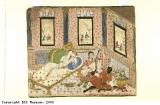The East African slave trade
The Indian Ocean stretches between the east coast of Africa and the west coast of India. It was once part of the route for a slave trade known as the ‘Oriental’ or eastern slave trade. From the 7th century enslaved Africans were taken to the Middle East, North Africa and India. This eastern slave trade was different to the slave trade across the Atlantic Ocean (the transatlantic slave trade ) from Africa to the Americas and the Caribbean. In the transatlantic slave trade the demand was for labourers to work on plantations and in mines, and mostly men were captured to supply the demand. In the eastern trade, the demand was for domestic servants, and mostly women were captured to supply the trade. This painting shows an Indian woman in a Chinese style room. The woman’s pale skin shows that she is high class, and her servant who is playing a lute also points to this. Sprawled on the floor beside the women is a young African pageboy, presumably a slave bought from east Africa to India. The end of the eastern slave trade began when the British ended slavery in India in 1843. Throughout much of the area, though, slavery remained legal until a country came under European rule (for example Egypt in 1882) or until the country tried to join the League of Nations after the 1st World War (for example, Saudi Arabia).
Slaves taken to the Middle East and North Africa were not just from Africa. Until about 1500, slaves were also bought from northern Europe, but as this supply route dried up the numbers bought from Africa increased. In the eastern slave trade enslaved Africans were taken from the east coast of Africa (the modern countries of Kenya, Tanzania, Mozambique and the island of Madagascar). They also came from the Savannah area (which includes countries such as Mali, Niger, Chad and Sudan) and the Horn of Africa (which covers Djibouti, Somalia and Ethiopia). Slaves were sold to merchants from North Africa and the Middle East. The women slaves in this trade often married their masters, or had children by them and the children were often freed by their fathers. Over time, the enslaved Africans tended to become part of the local population. In the transatlantic slave trade to the Americas, enslaved African women were often involved with their white masters, but it was usually an unequal relationship and the children were never free citizens. The mixed race children in the Americas were still slaves. The demand for women slaves in the eastern slave trade meant that the many men who were captured at the same time as the women remained as slaves in Africa. There were many plantations in, for example, Kenya (east Africa), where the enslaved men worked growing food and spices on plantations.
There are no records for the number of enslaved Africans sold before the 17th century from the Savannah area of Africa (which includes countries such as Mali, Niger, Chad and Sudan) and the Horn of Africa (which covers Djibouti, Somalia and Ethiopia). It is estimated that in the 17th century, about 10,000 slaves per year were sold to North Africa and the Middle East. There was a large domestic slave population in this area and slavery was an accepted form of labour amongst the rulers of the different kingdoms. Small numbers of enslaved Africans were sold from the east coast to other areas including the Persian Gulf and India for hundreds of years. (The Persian Gulf is today the area including Iran, Iraq, Saudi Arabia, Oman and the United Arab Emirates). The numbers of enslaved Africans sold to these areas increased in the late 18th century. This was because French merchants bought slaves from East Africa for the growing sugar plantations on the French owned islands in the Indian Ocean. Brazilian merchants also began buying slaves from the same area for the sugar plantations in Brazil, after 1800. Then, trade to the Persian Gulf and India increased rapidly. By the early 19th century about 30,000 people were being sold into slavery from this eastern area of Africa. They were being bought and sold through the main centre of the trade on the island of Zanzibar (off the east coast of Africa, of what is now the country of Tanzania).
It has been estimated that over the twelve centuries from 750 to the 20th century (slavery continued in this area well into the 20th century, and beyond) almost 12,000,000 enslaved Africans were traded to the Middle East, North Africa and India. The eastern slave trade , over a much longer period, took from Africa about the same numbers of people as the transatlantic slave trade took in 300 years.



